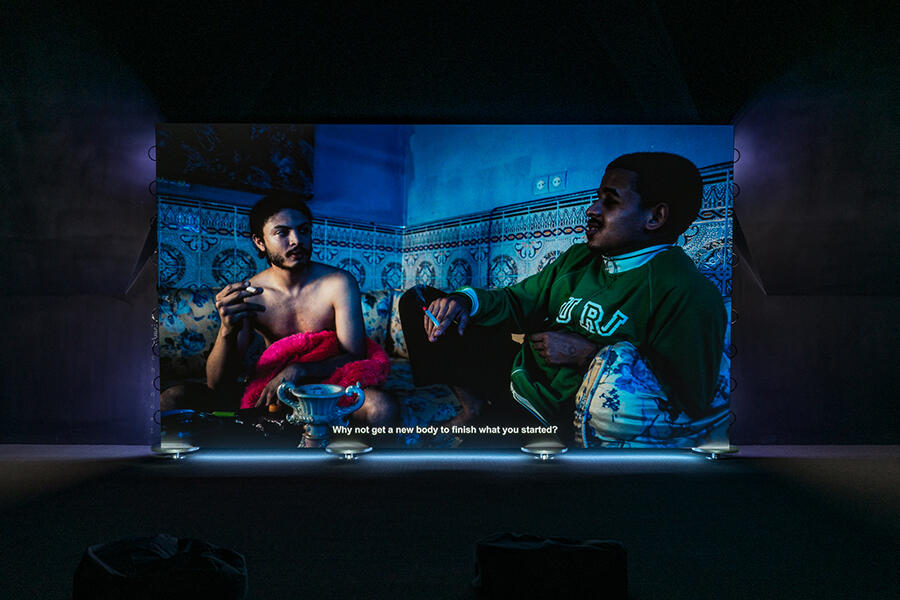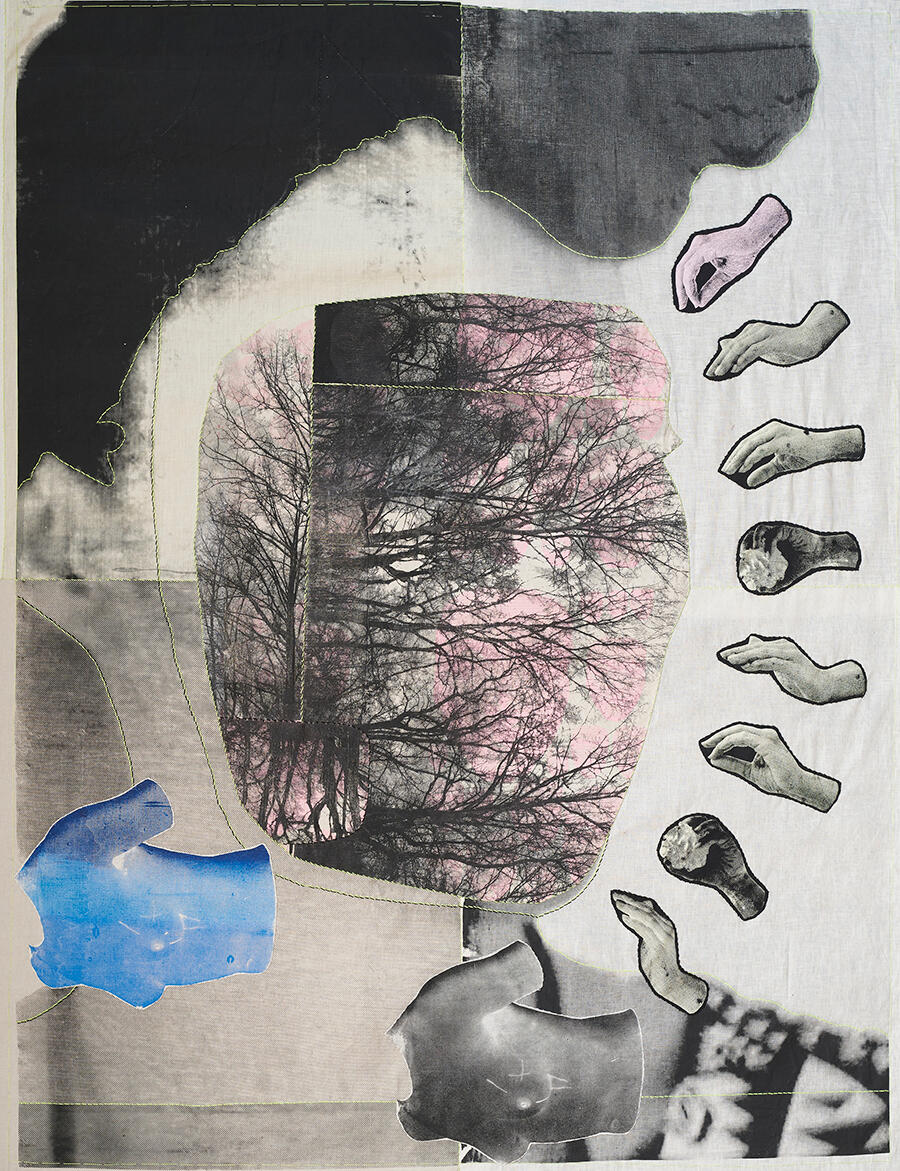What to See During EXPO Chicago
From Meriem Bennani’s supernatural film at Renaissance Society to Devan Shimoyama’s transformative paintings and sculptures at Kavi Gupta, these are the must-see shows in Chicago
From Meriem Bennani’s supernatural film at Renaissance Society to Devan Shimoyama’s transformative paintings and sculptures at Kavi Gupta, these are the must-see shows in Chicago

Meriem Bennani
Renaissance Society
26 February – 17 April

CAPS, the futuristic island created by Moroccan-born artist Meriem Bennani for her film trilogy ‘Life on the CAPS’ (2019–22), is a detention camp turned metropolis. Its inhabitants descend from families brought there for ‘illegal’ transportation and are subject to a secretive, police state-like authority. Concluding the trilogy, Bennani’s eponymous new film follows the daily lives of CAPS residents, including Kamal, who has just been given a new body so that he can double his lifespan and live to see the liberation of CAPS. Like Bennani’s previous films, Life on the CAPS (2022), now showing at Renaissance Society, intricately and colourfully blends a variety of live footage – shot in Marrakesh – and animation to investigate geo-politics through a post-colonial lens. The fantastic elements strung throughout Bennani’s films unveil the reality and myth-making that, per the press release, are ‘deeply intertwined in an individual’s life under the nation state’.
Zohra Opoku
Mariane Ibrahim Gallery
8 April – 14 May

On Zohra Opoku’s I have arisen from my egg … (2020), the face of a screen-printed sepia portrait is replaced with mustard-yellow tree branches, stitched-on hands reach out for the missing face, while an eye, nose, ear and mouth float on the bottom of the canvas. Opoku’s new body of work – now showing at Mariane Ibrahim as part of ‘I Have Arisen … The Myths of Eternal Life, Part One’ – comes after the artist’s cancer diagnosis and shows bodies piecing themselves back together, reclaiming themselves. Egyptian hieroglyphs frequently appear paired with hands, granting them a symbolic quality. The trees come from a series of photos the artist took in Berlin while undergoing radiation therapy; stripped of their leaves, the branches hint towards new life and blossoms.
Theodora Allen
Driehaus Museum
26 March – 10 July

Theodora Allen’s ‘Saturnine’, now on view at the Driehaus Museum, is the artist’s first solo institutional survey in the US, following an earlier iteration at Kunsthal Aarhus, Denmark. Her impressive painting The Cosmic Garden I (2016) previews the symbolic, medieval illuminated manuscript-like qualities of many of the other works on view here: the cyanotype-like canvas presents a framed Saturn, imposing but not threatening, surrounded by blue-green plants sprouting from a windowpane. Sparse yet loaded with iconography, Allen’s paintings seem to fall within the spiritual lineage that encompasses William Blake and Hilma af Klint. In a triptych titled Syzygy (Narcissus) (2021), square comets streak across a stellar background, their comas containing the imagery found in other Allen paintings: hands holding insects, flowers sprouting on riverbanks. The works look stunning in the context of the Driehaus’s Gilded Age ornamentation, which accentuates their uncanny timelessness and quietly luminous qualities.
Devan Shimoyama
Kavi Gupta, Elizabeth Street
8 April – 11 June

Devan Shimoyama’s self-portrait Tempérance (2022) – now showing as part of ‘A Counterfeit Gift Wrapped in Fire’ at Kavi Gupta – depicts the artist as a blue angel with bejewelled eyes pouring water into an overflowing glass, like the subject of the temperance tarot card diluting its wine. The other paintings and sculptures in the show are similarly striking in their bright colours and use of materials like sequins and glitter, La Mort (Death, 2022) also derives from its eponymous tarot card: a grim reaper squats on the shore of a sequined river next to a decapitated head and Rihanna’s disembodied hand, recognizable from the singer’s distinctive tattoos. Says Shimoyama in the press release: ‘I think about the death and rebirth of [Rihanna’s] career. People wanted more, but she pivoted and didn’t deliver in that capacity. I’m going through similar shifts in my life that are substantial. This is a moment of rebirth in a lot of different ways.’
Aleshea Harris
GRAY Chicago
31 March – 16 April

For three weeks, GRAY gallery has been converted into a theatre, showing the Chicago début of Aleshea Harris’s What to Send Up When It Goes Down (2018). At once a ritual, a dance party and a musical, Harris’s play responds to the loss of Black lives at the hands of US law enforcement. Bringing the production to Chicago has special significance, says Theaster Gates in the press release (his Rebuild Foundation is supporting the What to Send Up): ‘The role that Black artists and Black cultural institutions in Chicago play in shining a light on injustice is paramount to dismantling systems that perpetuate racialized violence against Black bodies.’ The cast of eight performs a series of vignettes, in part with audience participation, to both mordant and sobering results. The play – intended for a Black-identifying audience – creates a space for catharsis and healing. In a 2019 interview with American Theatre, Harris shares the impetus for the work: ‘[H]old people accountable, be confrontational, let it be messy, let it be angry, and let it tread as absurdly as the idea that a Black person could be killed on camera unarmed and the person who killed them get away with it. […] I wanted to mirror that absurdity in the form of the play.’
Main image: Zohra Opoku, ‘I have opened the doors of truth. I have passed the waters of heaven. I have raised up a ladder to heaven among the gods. I am one who is with you. I have spoken as a semen-goose, (and) the gods hear my voice.’, 2020–22, screenprint on linen. Courtesy: the artist and Mariane Ibrahim Gallery, Chicago




















